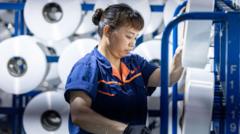China's economy has exhibited signs of strain recently, with new data revealing a slowdown in growth amid turbulent trade relations and issues in the property market. The latest reports from the National Bureau of Statistics indicate that the world’s second-largest economy grew 5.2% in the second quarter of the year compared to last year, down from 5.4% in the preceding quarter.
Despite these challenges, the economy has avoided a significant downturn, buoyed by governmental initiatives aimed at stabilizing growth and a fragile truce in trade tensions with the United States. In a statement, officials noted that "the economy withstood pressure and made steady improvement despite challenges." Notably, the manufacturing sector experienced a 6.4% expansion, spurred by increased demand in emerging technologies, including 3D printing, electric vehicles, and industrial robotics.
However, the country's retail sector has started to show weakness, with growth in retail sales dropping from a 6.4% increase in May to just 4.8% in June. Additionally, newly reported statistics show a decline in home prices, indicating ongoing struggles in the real estate market. These pressures raise concerns about meeting China's annual growth target of around 5%, with some analysts predicting growth could fall to around 4%, which is viewed as a minimum politically acceptable level.
The trade battle between United States President Donald Trump and China's President Xi Jinping has resulted in significant tariffs, including a staggering 145% tax on some Chinese imports from the US and reciprocal duties levied by Beijing on American goods. While negotiations held in Geneva and London have led to a temporary suspension of some tariffs, a concrete long-term trade agreement remains unfinished, with the deadline set for August 12.
As China navigates these challenges, the focus remains on finding potential pathways for sustained growth amid an unpredictable global economic landscape.





















